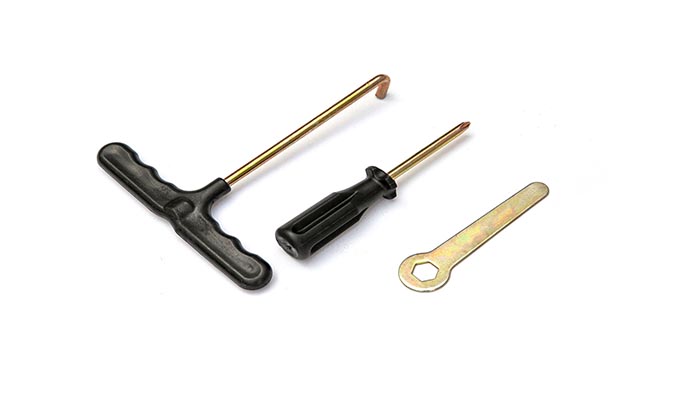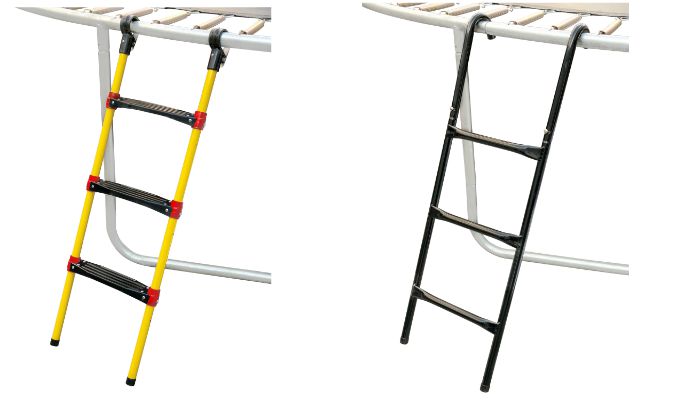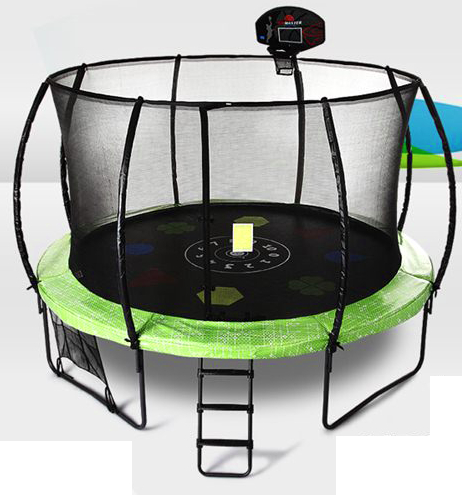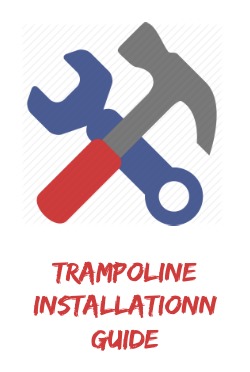 An outdoor trampoline is an important fun lawn accessory that provides the best entertainment for kids and adults.
An outdoor trampoline is an important fun lawn accessory that provides the best entertainment for kids and adults.
An outdoor trampoline is an important fun lawn accessory that provides the best entertainment for kids and adults.
I am pretty sure, everybody craves to have this equipment,
However,
the installation process has always been the greatest challenge for most individuals.
I will take you through a step-by-step installation process of a round outdoor trampoline.
This is one of the most common types of trampoline in the market.
I have assisted over 9,763 clients to install trampolines of all types, however, I have noted one major problem – most people don’t even know the specifications of the trampolines they own.
Leave alone the various components of a trampoline such as frame tube, mats, springs, pads, enclosure, etc.
To see a sample of what I am talking about then, you can follow this link: round trampoline product specification.
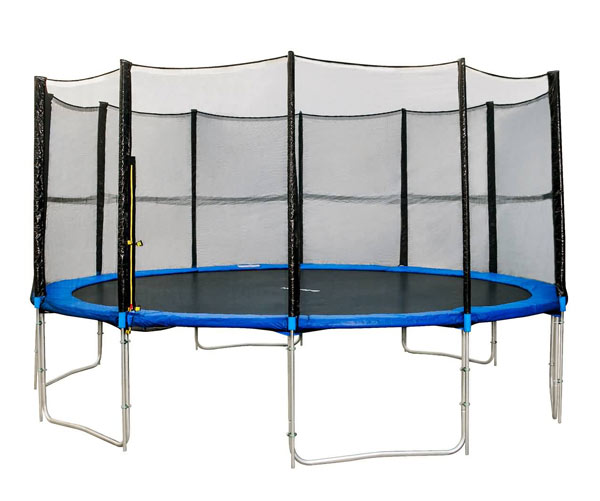 This is an example of a round trampoline that is used in the outdoors
This is an example of a round trampoline that is used in the outdoors
You need to understand the basic components that make up a trampoline.
An outdoor trampoline assembly/installation information
There are a number of factors you need to consider before you begin the installation process.
They include:
1.Get the right trampoline installation tools and you must use them to do the right tasks designed for the tools.
Some of these tools may be included in the trampoline or you’ll have to purchase them from a local hardware.
You need a screw driver, rubber mallet, 2 adjustable wrenches and trampoline spring tools.
2.You need protective equipment such as gloves to protect your hands from pinch points and a hard hat to protect your head.
3.The frame pads must be installed properly before installing the trampoline enclosure.
4.The installation process requires two or more adults. No child should play around or near the trampoline until the installation process is complete.
5.The installation process should be done on a level surface.
6.You must ensure that there is enough overhead clearance within the exact location where you want to install the trampoline.
NOTE: All trampolines come with the manufacturer’s instructions, you need to read and understand all that it entails.
I know quite a number of people don’t like reading these manuals, however, for the purposes of the outdoor trampoline installation, you must read this.
In fact, it is among the 21 trampoline safety tips that may save your child’s life I do recommend.
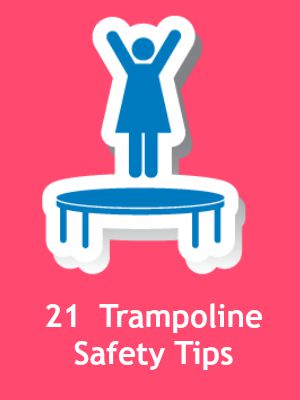
Well, now we can commence our installation process.
Step-by-step Trampoline Assembly Process
For the purpose of this guideline, I will use the images below to illustrate the process.
Generally, the numbers refer to various sections of a trampoline that have been disassembled.
They are the components that make up the structure of a round trampoline in the figure above. The figure above is a fully assembled outdoor trampoline.
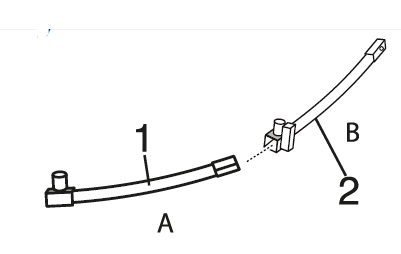
The trampoline components 1
Are you able to recognize these sections in the fully assembled trampoline in the figure above?
Well, you should since it will help you to understand my installation process.
You need to unpack your trampoline and identify these sections.
The number of sections will depend on the size of the trampoline you have.
These tubes have two distinct features that you need to note: tube 1 has a T-joint while tube 2 has a socket.
On these tubes, you should take note of small holes too. This is where you will attach the trampoline springs. These small holes should face the ground.
Place tube 1 and tube 2 on a flat ground then you should insert tube 1 into the socket in the tube 2 as indicted by the dotted lines above.
You should have a structure that resembles this:
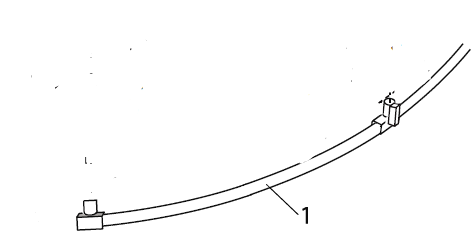
The joined sections of part 1 and part 2

Try to be keen enough to identify the sections in the image below.
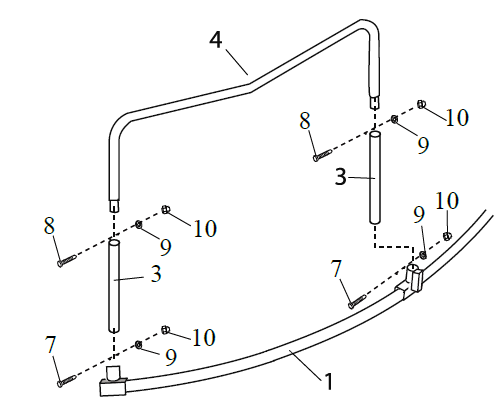
The joined section in step 1 with other components of the round trampoline
NOTE: Part identification is essential in the trampoline installation process.
Before you move to any installation stage, you should be able to identify a part and match it to the final image of the product you expect.
The parts are numbered. In case you haven’t seen them before, I will list the part and the corresponding part number in the table below.
This is just for illustration purposes. In most cases, the manufacturers will can use names, letters or number. This depends on the one they feel is convenient.
|
Part No. |
Part Name |
|
3 |
Leg extension |
|
4 |
Leg brace |
|
7 |
Bolt (dimension may vary) |
|
8 |
Bolt (dimension may vary) |
|
9 |
Washer |
|
10 |
Nut |
At times, the bolts and nuts may vary in sizes. Take for instance, in the situation above.
The bolt that will secure the leg extension and the leg brace may not be of the same size as the one that secures part No. 1 and the leg extension.
In the image above, I have dotted lines. These lines indicated how you should insert these sections.
With the peak of the brace leg facing downwards, insert the leg extensions on the leg brace and secure them using a nut, washer and bolt. Be sure to do the same to both legs.
Do you remember our first structure in step one? In this image, we have marked it No. 1. It has T-joint and a socket.
Now that you have assembled the leg extensions and the leg brace, you need to pull it out slightly and insert one end on the T-joint and the other end on the socket.
You should secure the two sections using bolts, washers and nuts.
You should repeat the steps one and two above for all the leg braces and leg extensions for all the remaining parts. They should resemble the image below when you place the leg brace on the ground.
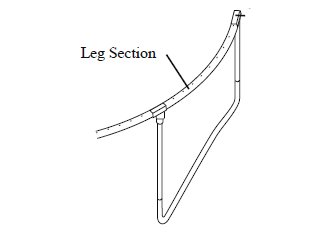
Assembled parts for sections from step 1 and step 2
By doing this, you shall have made the leg section of you out door trampoline.
Does it resemble the legs in the image above?
I hope you can begin to see a vivid picture of how we are trying to assemble this structure.

As you assemble these sections, you’ll realize that the part No. 1 above has two ends:a smaller end (commonly referred to as the male) and a larger end (commonly referred to as the female).
Let’s have a look at what we have:
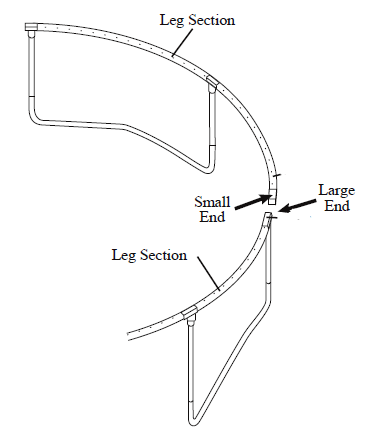
Two of the parts assembled in step 2 above
Once you have these, slide the smaller section into the larger section.
You need to push this slowly to ensure that they are secure.
You can’t do this alone, this is why I recommended that you need someone to help you with the trampoline assembly process. You need to repeat this process until you have all the sections joined together.
You should also remember that there are those trampolines where you’ll be required to secure these sections using nuts and bolts. Don’t forget this. By the end of this step, you should have a circular structure.

It’s now time to think of how we are going to install our jump mat.
I am assuming that you had chosen a good material for your jump mat.
You need to specify this when you place an order for this product.
NOTE: for this section, we shall use the following part numbers of illustration purposes:
- 5 to denote jump mat
- 7 to denote trampoline enclosure mesh
- 11 to denote trampoline springs
With the assembled frame already assembled, place the trampoline on ground within the frame.
There are a number of things I want you to note here:
- The enclosure door and the T-joint should be aligned.
- You should be able to locate the mark that denotes the center of the jump mat.
- You must wear gloves as you attach the springs
In case, the enclosure mesh was not pre-installed in the company, you’ll have to do it.
Don’t worry, it is a simple process. For pre-installed ones, you need to inspect whether the V-ring was fitted correctly or not.
After you have placed the mat within the frame, insert one V-ring on the trampoline jump mat and attach it to one of the buttonhole incisions that are on the bottom edge of the trampoline enclosure mesh.
You should insert V-rings in all the desired locations. Ideally, you need to have an image, which resembles this:
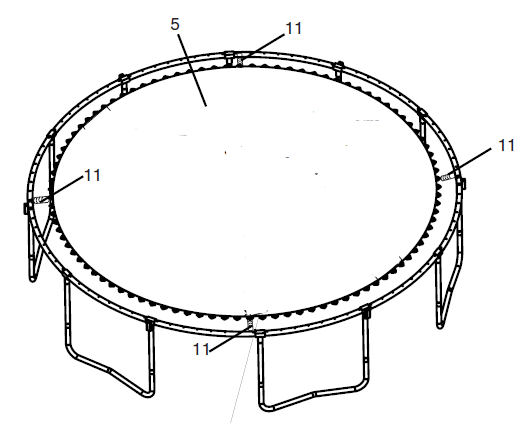
An image showing a ready frame with a trampoline net just about to be installed
After you have inserted all the V-rings, it is time to install the trampoline springs. You need to be careful as you try to install the springs since they may spring back and this may cause injury.
You need to use the spring tool (labelled 12) as illustrated in the figure below:
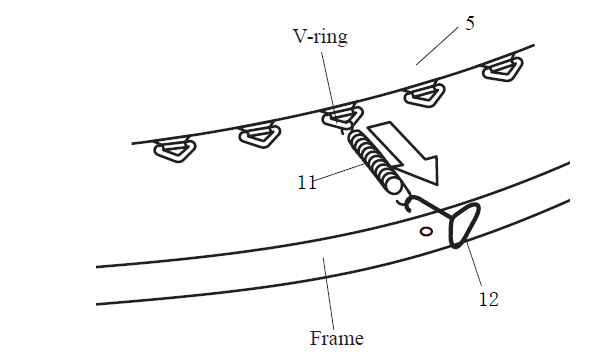
Installing the trampoline springs on the trampoline frame
You need to identify the enclosure opening, attach the spring on the V-ring and use the spring tool to attach the spring on the trampoline frame.
You can skip 24 holes in the clockwise or anti-clockwise direction and attach the second spring.
Count another 24 holes then attach the third spring. You need to continue with this process until you attach all the springs to trampoline mat and frame.

You should install the trampoline frame pad on the frame. It should rest between the holes and the frame.
The frame pads are essential safety measures that reduces chances of jumpers coming in contact with the trampoline frame.
It is an important safety measure. These pads have straps that you should use to tie the strap on the other side of the frame.
Basically, this is how it should appear:
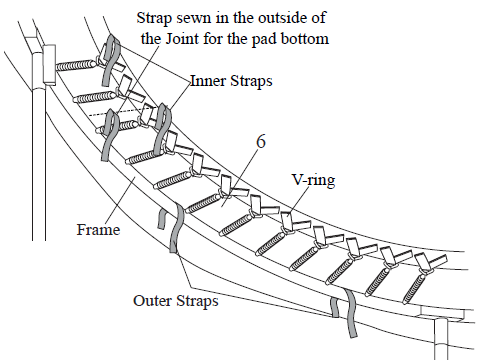
How to install the trampoline frame pad
Below is how the upper section of the trampoline will look like:
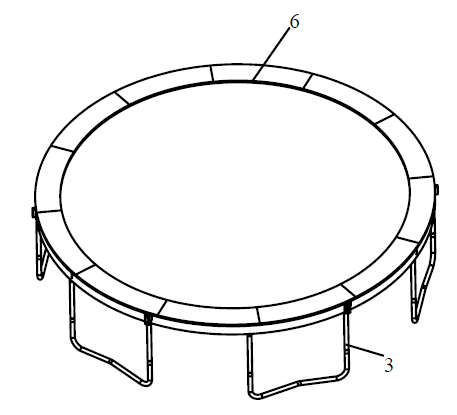
A trampoline with a frame pad installed
Basically, with these simple steps, we can proudly say that we have assembled our outdoor trampoline.
It is a simple process, however, you don’t need to rush over it. This is because any mistake at this point can be very detrimental to the trampoline users.

You should install the trampoline ladder.
This will make it easier for your kids to access the trampoline.
Without a ladder, your kids will have to jump onto and from the trampoline. This is very risky since they are likely to break their limbs.
You can choose from a wide range of trampoline ladder materials available in the market.
Again, as a safety measure, you need to choose those with rubber coat. This will prevent the user from slipping of the ladder.
Additional Outdoor Trampoline Installation Considerations
The number of trampoline users getting injured has increased in the recent past.
It is for this reason that I have always instead on ensuring that trampoline users remain safe.
Some of these safety measures include:
-
The trampoline safety nets
Before the kids begin to use the trampoline, you need to install this safety nets.
They come in a wide range of designs and configurations. However, it is the material that plays a significant role here. You may have a look at a guide to better safety nets materials.
Again, it is important to understand the how a safety net can save a child’s life. It is this simple, if you can’t install a safety net, then don’t install the outdoor trampoline.
2. The LED lighting systems
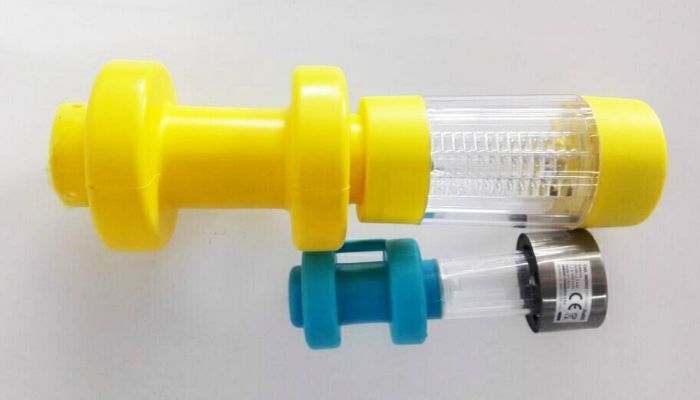
Installing the trampoline solar lights has also become a common practice on trampolines.
The flashing LED for trampolines have also improved safety and jumping experiences. Thou this may not be a necessity, you need to consider it too.
Here is also a great video for trampoline installation, check it here.
Conclusion
As I conclude, I think we need to adopt a good installation process for all our outdoor trampolines. This can be a demining process, especially if this the first time you intend to install a trampoline. Instead of opt for the trial and error process you can hire a professional to assist you in the installation process.

